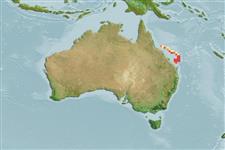Elasmobranquios (tiburones y rayas) (sharks and rays) >
Rajiformes (Skates and rays) >
Rajidae (Skates)
Etymology: More on author: Ogilby.
Environment: milieu / climate zone / depth range / distribution range
Ecología
marino batidemersal; rango de profundidad 135 - 400 m (Ref. 114953). Subtropical; 18°S - 24°S, 148°E - 154°E (Ref. 114953)
Distribución
Países | Áreas FAO | Ecosistemas | Ocurrencias, apariciones | Point map | Introducciones | Faunafri
Western Pacific: off Queensland, eastern Australia.
Length at first maturity / Tamaño / Peso / Age
Maturity: Lm 28.0, range 26 - 30 cm
Max length : 36.0 cm TL macho / no sexado; (Ref. 6871)
Short description
Claves de identificación | Morfología | Morfometría
Dorsal surface pinkish brown to greyish brown with irregular clusters of small, dark, white-edged spots. Ventral surface pale, occasionally with dark patches around mouth and central disc. Dorsal fins uniform pale brown. Disc quadrangular, broader than long. Snout short to moderate. Tail of medium length, depressed, slender; lateral skin folds well developed. Nuchal thorn small. Orbital thorns usually absent from mid-eye, usually less than 5 in mature specimens. Mature males with denticles along anterolateral margin.
Found on the outer continental shelf and upper slopes. Bottom-dweller which feeds on invertebrates, mainly on crustaceans such as shrimps and prawns (Ref. 114953) and bony fish (Ref. 9908). Oviparous (Ref. 50449). Eggs have horn-like projections on the shell (Ref. 205). Males reaches maturity at ca. 30 cm TL, females at ca. 32 cm TL (Ref. 114953).
Life cycle and mating behavior
Maturities | Reproducción | Spawnings | Egg(s) | Fecundities | Larva
Oviparous (Ref. 9908). Paired eggs are laid. Embryos feed solely on yolk (Ref. 50449).
Last, P.R. and J.D. Stevens, 1994. Sharks and rays of Australia. CSIRO, Australia. 513 p. (Ref. 6871)
IUCN Red List Status (Ref. 130435)
Human uses
Herramientas
Special reports
Download XML
Fuentes de Internet
Estimates based on models
Preferred temperature (Ref.
123201): 19.7 - 20.5, mean 19.8 °C (based on 6 cells).
Phylogenetic diversity index (Ref.
82804): PD
50 = 0.5010 [Uniqueness, from 0.5 = low to 2.0 = high].
Bayesian length-weight: a=0.00302 (0.00141 - 0.00645), b=3.24 (3.07 - 3.41), in cm total length, based on LWR estimates for this (Sub)family-body shape (Ref.
93245).
Nivel trófico (Ref.
69278): 4.0 ±0.61 se; based on food items.
Resiliencia (Ref.
120179): Bajo, población duplicada en un tiempo mínimo de 4.5-14 años (Fec assumed to be <100).
Fishing Vulnerability (Ref.
59153): Low to moderate vulnerability (26 of 100).
